On Saturday, September 24, we left Cochem early and caught the 8am train to Wurzburg, a city on the "Romantic Road." It's called the Romantic Road because along the route are a number of Medieval walled cities that are supposed to look, well, romantic. Since we didn't have a car, and the bus sounded like a headache, we decided to just visit the three cities along the Romantic Road that are easily accessibly by train. Wurzburg was our first stop.
We arrived in Wurzburg about 11am. We stowed our backpacks in lockers at the train station and headed out to explore the town. The walk from the train station to the city center took just 10 minutes. Along the way, we picked up sandwiches to go, intending to just walk and eat. But we found that we were still hungry and feeling rather sleepy since we'd missed breakfast (and coffee!) at the B&B. So we found a little cafe and got a cup of coffee and a dessert and just relaxed for a minute. As soon as our energy returned, we continued on seeing Wurzburg.
Wurzburg was surprisingly crowded and felt rather modern - not exactly what I had expected from the Romantic Road. We followed Rick Steves' walking tour, which lead us around the city center, identifying various points of interest along the way. We saw the red Kilian's Cathedral (which Rick Steves says is named for a wandering Irish bishop who preached there). Then we wandered across the Old Bridge, which is lined with statues of saints and Prince Bishops from Wurzburg's past. From the bridge, we caught a glimpse of the Marienberg Fortress - a 13th-century fortified hilltop retreat.
Then we wandered across the Old Bridge, which is lined with statues of saints and Prince Bishops from Wurzburg's past. From the bridge, we caught a glimpse of the Marienberg Fortress - a 13th-century fortified hilltop retreat.
Then we toured the Residenz- a palace dating back to 1720 which was home to Wurzburg's "Prince Bishop" - a man with both political and religious power. Today, the middle section is open for tours and furnished in its original style. The rest is used as city administration offices and a university. Incredibly, much of the Residenz had to be completely rebuilt and restored after it was destroyed in a fire during WWII.
The Residenz was a spectacular palace! When you enter the main doors, the first thing you see is an enormous fresco on the ceiling with scenes depicting each of the continents as they thought of them back then (except Australia). The artists got their ideas of what exotic animals they'd never seen looked like from books, so some of them were pretty humorous. Our guided tour took us through a number of elaborately decorated rooms. Many had incredibly intricate details made of stucco - some all white, some gilded. Other rooms had paintings on the ceiling. The hall of mirrors was probably the most impressive. Every wall was covered in mirror pieces, together with gold and other artwork.
Since the other main attraction in Wurzburg, a large church, was closed for renovations, we departed Wurzburg after touring the Residenz. We walked back to the train station, picked up our bags, and continued our journey down the Romantic Road by train. Our next stop (where we'd be spending the night) was Rothenburg ob der Tauber.
It was getting dark by the time we arrived in Rothenburg, but even walking through the city gate at dusk, we could tell this place was special. We checked into our hotel, the Pension Elke, then headed out for dinner. We went to the Rick Steves recommended Altfraenkische Weinstube. It's located in a quiet part of town, tucked away on a little side street. We almost didn't see it because the front is covered in ivy, nearly concealing the door! The inside felt like a cozy little hobbit hole. It had exposed wooden beams, knick-knacks all over every wall, bunches of dried herbs and flowers hanging from the ceiling, all dimly lit by the fireplace and candle light. Our food and wine was delicious. It was quite the experience!
Day 9
On Sunday, September 25, we spent the entire day exploring Rothenburg ob der Tauber. We instantly fell in love with the city! It's everything we hoped the Romantic Road would be and more. It ended up being our favorite place in Germany.
Walking around, you could almost believe you'd stepped back in time. It feels very authentically Medieval because it really is. Rothenburg dates back to the 10th century. It was a Free Imperial City throughout the Middle Ages. This, together with its location at the cross roads of two important trade routes, allowed the residents to become wealthy and the city expanded quickly. It reached its height in the 15th century when it was the second largest city in Germany with 6,000 residents. Thanks to its strategic position up high on a cliff, its wealth and alliances, Rothenburg survived the centuries nearly unharmed. But following the Thirty Years War in the 1600's, the city became poor and fell dormant. It was largely forgotten and went undeveloped for centuries. In the late 1800's, it was "rediscovered" and began its transformation into the tourist hot spot it is today. Thanks in large part to its international popularity, it miraculously avoided destruction during WWII. Now, as Germany's best preserved walled town, with strict rules governing its development, it is like a Medieval theme park. Certain parts can be a bit touristy, but Rothenburg manages to retain its magic despite the crowds of people. Especially in the evening after the day trippers have left, it is truly an enchanting and wonderful place.
 |
| The Pension Elke, where we stayed |
 |
| Altfraenkische Weinstube, the hobbit hole restaurant where we ate the night before |
 |
| Market Square |
 |
| Market Square |
|
Clock tower
|
| Rathaus (Town Hall) |
 |
| Merchant buildings in Market Square |
Next we visited the Reichsstadtmuseum (Imperial City Museum), which is located in what used to be the Dominican convent cloister. On display are a wide variety of items from Rothenburg's past, spanning nine centuries! Collections including art, sculptures, pottery, furniture, weapons and armor. You can also see the convent's kitchen, which dates back to the 13th century. It is the oldest convent kitchen in Germany. In fact, you can't actually enter it due to the danger of collapse.
 |
| The Reichsstadtmuseum (Imperial City Museum) |
 |
| This mechanical bear in the window blows bubbles! |
Because Rothenburg grew so quickly during its heyday in the Middle Ages, the city wall had to be expanded a number of times. So there are a number of old city gates now located within the city's walls.
The Markus and White towers are the original gates to Rothenburg, dating back to the 12th century.
 |
| Markus tower |
 |
| Markus tower |
 |
| Markus tower |
 |
| White tower |
 |
| White tower |
 |
| The Galgen Tower |
 |
| If invaders ever made it to this gate, hot pitch would have poured down on them from the mouth of the mask! |
Rothenburg was built high on a hill to make it easier to defend. The southern part of the city sits on the edge of a steep drop off. Here the wall is low since it would have been nearly impossible for an army to attack from this side. This offers a great view of the city center across the valley!
 |
| The Burgtor (Castle Gate) |
 |
| There's even a moat! |
 |
| St. Wolfgang's Church, also known as the Shepherd's Church |
We climbed up in the Rodertor gate.
The views from up on the wall were fantastic. The sea of red tile roof tops was magnificent in the light of the setting sun!
At 8pm, we joined a large group in the Market Square for the Nightwatchman's Tour. The tour guide dresses up in Medieval garb, complete with a weapon and a lamp. He even sports kind of unruly hair and a beard - he totally looks the part! While his tour was informative, it was far more entertaining than anything else. He intertwines Rothenburg history with jokes like a stand up act. He's really hilarious! We learned that people in Medieval times were very superstitious and didn't like anything associated with death or night. Therefore, the nightwatchman was one of the lowest occupations. The only ones lower were the executioner and the undertaker. Nightwatchmen kept a lookout for invaders, but also fire, since that was one of the biggest threats at that time, especially at night. Hardly anything worse could happen! If he spotted fire, he'd blow his horn. Our tour guide actually had a horn and he blew it as a demonstration. Being a Nightwatchman was a dangerous job, because all of the respectable people were home in bed - the only ones out at night were thieves and drunks. But he said, "Now it's much safer because all of you go with me!" It was a great end to our stay in Rothenburg.



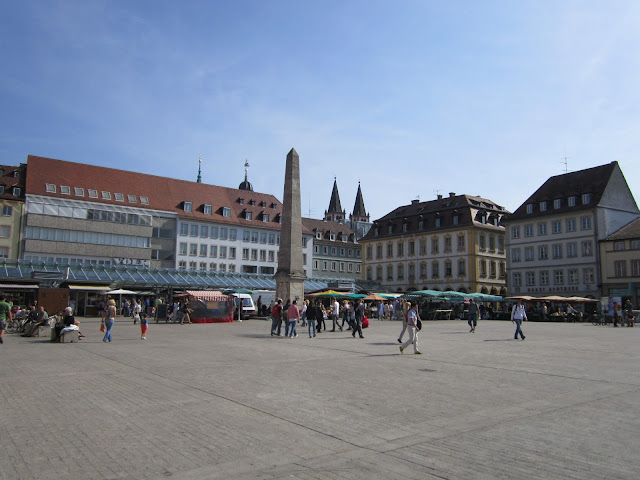
















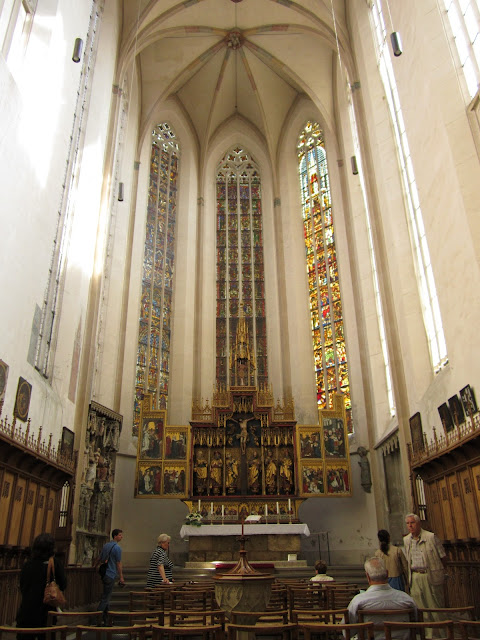

































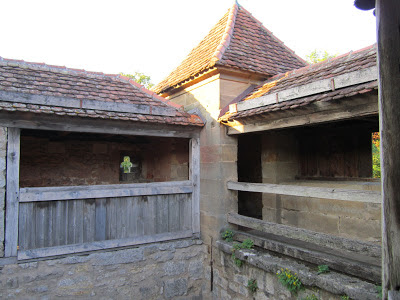




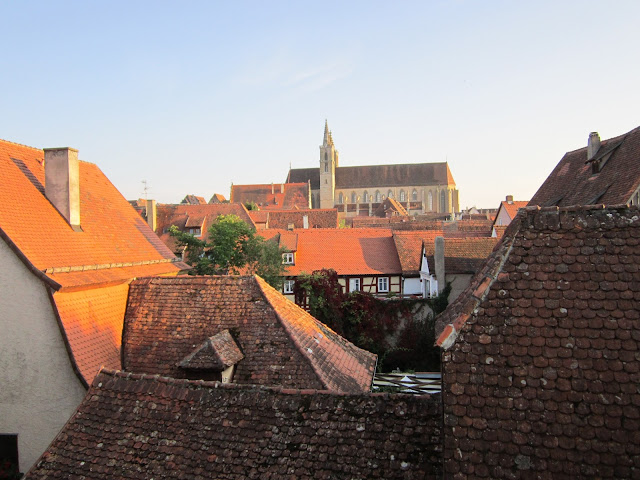



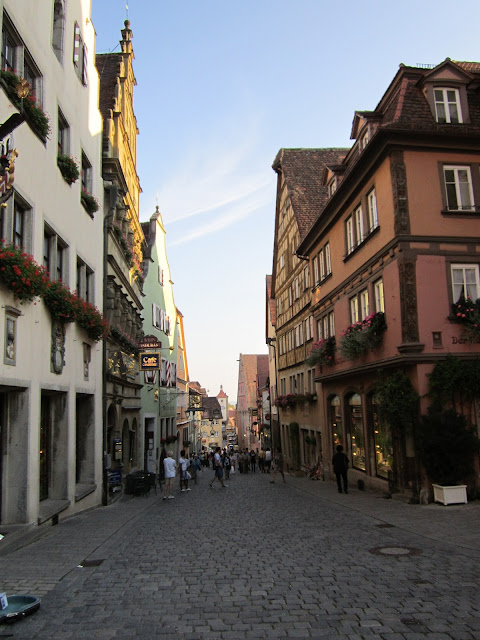









No comments:
Post a Comment